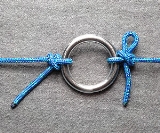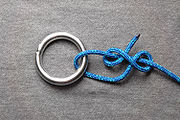
Buntline hitch
Encyclopedia
The buntline hitch is a knot
used for attaching a rope
to an object. It is formed by looping the rope (or other tying material) around an object, then making a clove hitch
around the rope's standing part, taking care to tie the two half-hitches that compose the clove hitch in the direction of the object, rather than away from it. Secure and easily tied, the buntline hitch will jam when subjected to extreme loads. Given the knot's propensity to jam, it is often made in slipped form.
 Simple and effective, the buntline hitch dates to the age of sail
Simple and effective, the buntline hitch dates to the age of sail
, where it was used to secure buntlines
to the foot
of the sails on square-rigged
ships. That the buntline hitch was the preferred knot speaks to its security and reliability. Once set, repeated jerking and slatting tend to tighten it further rather than loosen it. Its compact size allowed the foot of the sail to be drawn up as closely as possible to the buntline deadeyes
on top of the yard
.
It has gained in popularity in recent years due to its performance in slippery modern synthetic lines.
will result. Although not generally required, a round turn can first be made around the object causing the buntline hitch to be even less prone to slipping.
 The buntline hitch is useful for attaching lines to rings, eyes, posts, rods, and railings where a compact and secure knot is required. The non-slipped form is appropriate for moderate loads or where the knot will not need to be untied often. If heavily loaded it can be difficult or impossible to untie without the aid of a marlinspike
The buntline hitch is useful for attaching lines to rings, eyes, posts, rods, and railings where a compact and secure knot is required. The non-slipped form is appropriate for moderate loads or where the knot will not need to be untied often. If heavily loaded it can be difficult or impossible to untie without the aid of a marlinspike
.
The slipped form is more versatile and convenient when a secure temporary hitch is needed. For example, the slipped buntline hitch is an excellent choice to fasten a line to one side of a vehicle's luggage rack, with a trucker's hitch
being used on the other side to tension the line over a load placed between them.
The buntline hitch is the same knot as the four-in-hand knot
used for necktie
s. When it is made in flat material in the manner used to fasten a necktie, the working end is brought more parallel to the standing part during tightening than generally seen when made in cylindrical cordage for load-bearing purposes.

The buntline hitch is simply a clove hitch tied around the standing part, with the turns of the clove hitch progressing towards the object.

The slipped variation is made by passing a bight
through on the final step instead of the end. To release, pull the bight back through knot by tugging firmly on the free end.
Knot
A knot is a method of fastening or securing linear material such as rope by tying or interweaving. It may consist of a length of one or several segments of rope, string, webbing, twine, strap, or even chain interwoven such that the line can bind to itself or to some other object—the "load"...
used for attaching a rope
Rope
A rope is a length of fibres, twisted or braided together to improve strength for pulling and connecting. It has tensile strength but is too flexible to provide compressive strength...
to an object. It is formed by looping the rope (or other tying material) around an object, then making a clove hitch
Clove hitch
A clove hitch is a type of knot. Along with the bowline and the sheet bend, it is often considered one of the most essential knots. A clove hitch is two successive half-hitches around an object. It is most effectively used as a crossing knot. It can be used as a binding knot, but is not...
around the rope's standing part, taking care to tie the two half-hitches that compose the clove hitch in the direction of the object, rather than away from it. Secure and easily tied, the buntline hitch will jam when subjected to extreme loads. Given the knot's propensity to jam, it is often made in slipped form.
History

Age of Sail
The Age of Sail was the period in which international trade and naval warfare were dominated by sailing ships, lasting from the 16th to the mid 19th century...
, where it was used to secure buntlines
Clewlines and buntlines
For the revolver, see Colt BuntlineClewlines and buntlines are lines used to handle the sails of a square rigged ship.Although the common perception of a traditionally rigged ship is that the sails are handled from "up in the rigging", the majority of the work is actually carried out from the deck...
to the foot
Parts of a sail
In sailing the parts of a sail have common terminology for each corner and edge of the sail.-The corners:In a triangular sail, the upper point is known as the head; the halyard, the line which raises the sail, is attached to the head...
of the sails on square-rigged
Square rig
Square rig is a generic type of sail and rigging arrangement in which the primary driving sails are carried on horizontal spars which are perpendicular, or square, to the keel of the vessel and to the masts. These spars are called yards and their tips, beyond the last stay, are called the yardarms...
ships. That the buntline hitch was the preferred knot speaks to its security and reliability. Once set, repeated jerking and slatting tend to tighten it further rather than loosen it. Its compact size allowed the foot of the sail to be drawn up as closely as possible to the buntline deadeyes
Deadeye
A deadeye is an item used in the standing and running rigging of traditional sailing ships. It is a smallish round thick wooden disc with one or more holes through it, perpendicular to the plane of the disc. Single and triple-hole deadeyes are most commonly seen...
on top of the yard
Yard (sailing)
A yard is a spar on a mast from which sails are set. It may be constructed of timber, steel, or from more modern materials, like aluminium or carbon fibre. Although some types of fore and aft rigs have yards , the term is usually used to describe the horizontal spars used with square sails...
.
It has gained in popularity in recent years due to its performance in slippery modern synthetic lines.
Security
While the buntline hitch is considered a very secure knot, the turns of the clove hitch must progress towards the object, otherwise the much less secure two half-hitchesTwo half-hitches
The two half-hitches is a type of knot, specifically a binding knot or hitch knot. It consists of an overhand knot tied around a post, followed by a half-hitch...
will result. Although not generally required, a round turn can first be made around the object causing the buntline hitch to be even less prone to slipping.
Usage

Marlinspike
Marlinspike is a tool used in ropework for tasks such as unlaying rope for splicing, untying knots, forming a toggle , or forming a makeshift handle....
.
The slipped form is more versatile and convenient when a secure temporary hitch is needed. For example, the slipped buntline hitch is an excellent choice to fasten a line to one side of a vehicle's luggage rack, with a trucker's hitch
Trucker's hitch
The trucker's hitch is a compound knot commonly used for securing loads on trucks or trailers. This general arrangement, using loops and turns in the rope itself to form a crude block and tackle, has long been used to tension lines and is known by multiple names...
being used on the other side to tension the line over a load placed between them.
The buntline hitch is the same knot as the four-in-hand knot
Four-in-hand knot
The four-in-hand knot is a method of tying a necktie. Also known as a simple knot or schoolboy knot, the four-in-hand is believed to be the most popular method of tying ties due to its simplicity...
used for necktie
Necktie
A necktie is a long piece of cloth worn for decorative purposes around the neck or shoulders, resting under the shirt collar and knotted at the throat. Variants include the ascot tie, bow tie, bolo tie, and the clip-on tie. The modern necktie, ascot, and bow tie are descended from the cravat. Neck...
s. When it is made in flat material in the manner used to fasten a necktie, the working end is brought more parallel to the standing part during tightening than generally seen when made in cylindrical cordage for load-bearing purposes.
Tying

The buntline hitch is simply a clove hitch tied around the standing part, with the turns of the clove hitch progressing towards the object.
Slipped variation

The slipped variation is made by passing a bight
Bight (knot)
In knot tying, a bight is a curved section, slack part, or loop between the two ends of a rope, string, or yarn. The term is also used in a more specific way when describing Turk's head knots, indicating how many repetitions of braiding are made in the circuit of a given knot.-Slipped knot:In order...
through on the final step instead of the end. To release, pull the bight back through knot by tugging firmly on the free end.

